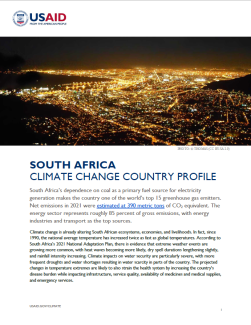Climate change is already altering South African ecosystems, economies, and livelihoods. Since 1990, the national average temperature has increased twice as fast as global temperatures. According to South Africa's National Adaptation Plan, there is evidence that extreme weather events are increasing, with heat waves more likely, dry spell durations lengthening slightly and rainfall intensity increasing. Climate impacts on water security are particularly severe, with more frequent drought and water shortages resulting in water scarcity in parts of the country. The projected changes in temperature extremes put additional strain on the health system, including the increasing disease burden, and affect aspects such as infrastructure, services, availability of medicines and medical supplies, and emergency services.
Government of South Africa Climate Priorities
The Government of South Africa’s climate priorities span climate adaptation and mitigation. The South African Cabinet has approved key climate actions, including passing the country’s first Climate Change Bill, while also creating a Presidential Climate Commission; developing key policy documents such as a Low Emissions Development Strategy and the National Climate Change Adaptation Strategy; implementing a carbon tax; and implementing a Just Transition Framework and Implementation Plan.
In its updated Nationally Determined Contribution (NDC), South Africa refined its mitigation targets for 2025 and 2030, with the latter aiming for emissions between 350-420 metric tons of CO2 equivalent. Critical sectors identified for mitigation were energy, waste, industrial processes and product use, agriculture, forestry, and other land uses.
The top adaptation goals in South Africa’s updated 2021 NDC include increasing institutional capacity; strengthening governance practices and legal frameworks; developing the scientific basis for strengthening the national and provincial governments’ readiness to respond to climate change; mobilizing funding for adaptation; and implementing the 2020 National Climate Change Adaptation Strategy. The 2020 National Climate Change Adaptation Strategy, for its part, seeks to: 1) build climate resilience and adaptive capacity to respond to climate change risk and vulnerability; 2) promote the integration of climate change adaptation response into development objectives, policy, planning, and implementation; 3) improve understanding of climate change impacts and build capacity to respond to these impacts; and 4) ensure resources and systems are in place to facilitate implementation of climate change responses.
At the United Nations Climate Change Conference (COP26), the U.S. government—together with the United Kingdom, France, Germany, and the European Union—announced a Just Energy Transition Partnership (JETP) with South Africa. The partnership supports South Africa’s accelerated energy transition away from coal and is helping the country chart a pathway toward a low-carbon economy that achieves national climate and socio-economic goals. This partnership is a global first and is making incremental progress two years into its implementation.
The JTEP political declaration committed to mobilizing an initial amount of roughly $8.5 billion, which has since grown to $9.3 billion with the addition in 2023 of Denmark and the Netherlands. It includes a combination of financial instruments (including multilateral and bilateral grants), concessional loans, guarantees, private investments, and technical support to enable the just energy transition.
Through Power Africa, USAID received an additional $45 million in financing to support JETP. Grant support aligns with South Africa’s needs and priorities, as outlined in the JETP Implementation Plan, to support the decarbonization of the energy sector and to support communities and workers impacted by the transition from coal to renewable energy.
USAID’S Climate Change Program: Objectives and Results
USAID supports the Government of South Africa’s development and climate priorities through bilateral and regional programs and partnerships supporting climate adaptation, renewable energy, and land conservation.
Adaptation
USAID strengthens resilience and water security in southern African communities and ecosystems in one of the world’s most climatically vulnerable regions through improved management of transboundary natural resources and increased access to safe drinking water and sanitation services.
Key Results
USAID has helped:
- Improve the capacity of more than 30 institutions in 2023 to assess or address climate change risks across Southern Africa, empowering ten local community institutions to better understand climate risks related to their use of natural resources and helping a number of regional government institutions to 1) integrate evidence-based decision-making into their institutional cultures; 2) more effectively communicate climate risks; and 3) improve land restoration and management practices under changing conditions;
- Support more than 12,000 people adapt to climate change across Southern Africa during 2023;
- Train South African National Parks managers and other stakeholders on Climate Risk Informed Decision Analysis, a collaborative climate impacts assessment tool for water resources;
- Strengthen 13 natural resources and protected areas management plans and policies across South Africa to include climate adaptation actions to build environmental resilience;
- Develop and implement climate- and biodiversity-smart agriculture to help communities adapt to climate change and related increased human-wildlife conflicts linked to rural food systems and water resources;
- Create Flood Forecasting Early Warning Systems to improve resilience within the transboundary Limpopo River Basin and its national member states, including South Africa; and
- Enhance climate responsiveness in the water security, sanitation, and hygiene sector by improving the interpretation and integration of climate-related data and considerations into municipal water safety plans and processes.
Energy
In support of the Power Africa Initiative, USAID also helps the Government of South Africa achieve its goals of transitioning the power sector to 42 percent non-fossil fuel sources by 2030 and reducing overall greenhouse gas emissions in line with the United Nations Framework Convention on Climate Change (UNFCCC) Paris Agreement targets. In partnership with national and sub-national authorities, USAID accelerates large-scale and distributed renewable energy deployment and is collaborating with the Government of South Africa to include critical energy efficiency initiatives in energy planning.
Key Results
USAID has helped:
- Bring 27 procurements to financial close under the Renewable Energy Independent Power Producer Procurement Program, resulting in 2,200 megawatts (MW) of new renewable energy generation and approximately $4 billion in investment;
- Finance small-scale renewable energy projects through a 15-year (2016–2031), $200 million loan portfolio guarantee to South Africa’s Industrial Development Corporation;
- Support projects that will cut greenhouse gas emissions by nearly 860,000 metric tons by 2030;
- Develop a “green economy” reference library to support municipalities working on renewable energy, energy efficiency, financing clean energy, green transport, and solid waste management;
- Support South African municipalities with energy planning, renewable energy procurement, and improved revenue collection from electricity distribution;
- Train South African women on renewable energy technology installation through technical, vocational education, and training colleges, equipping them to participate in a traditionally male-dominated industry and fostering a more inclusive workforce;
- Connect 700 informal dwellings to the national grid, advancing the country’s national electrification goals; and
- Create a demand-side management analysis that assessed strategies to optimize power consumption and reduce peak load stress in South Africa.
Key USAID Programs
South Africa National Climate Symposium
In 2024, USAID supported the South African National Treasury’s first Climate Symposium. The Symposium integrated climate into fiscal policy—along with planning and budgeting across local and national government—and helped advance a just energy transition. The Symposium also brought climate to the forefront of the Government of South Africa’s strategic priorities and aligns with the U.S. Government's commitment to addressing climate challenges through international collaboration and the interagency JETP initiative.
Demand Side Management and Energy Efficiency in South Africa
USAID, through the US Lawrence Berkeley National Laboratory, is supporting the Government of South Africa and local governments across the country in their efforts to design a demand-side management program to save energy rapidly and sustainably, alleviate pressure on the electrical grid, and reduce greenhouse gas emissions. Crucial components to this initiative involve the recalibration of the National Energy Efficiency Strategy, the design of pilot programs to reduce household water heating energy demand, and support to the national Department of Energy and Electricity to integrate demand-side management as a viable energy resource in national planning.
Climate Change Advisors
Through direct support to the Climate Change Branch at South Africa’s Department of Fisheries, Forestry, and Environment, USAID is enhancing the technical capacity of the Government of South Africa by providing five climate change professionals to support a broad range of efforts, including South Africa’s national Climate Change Bill, Climate Finance strategy, and Just Energy Transition Framework. These climate change advisors are also helping strengthen greenhouse gas inventory, reporting, and verification, along with other global reporting responsibilities under the UNFCCC Paris Agreement. This support ends in November 2024.
Updating South Africa’s Long-Term Emissions Development Strategy
USAID is providing technical assistance to update both South Africa’s Long-Term Low Emissions Development Strategy (LT-LEDS)—which will provide the basis for updating the 2030 component of South Africa’s NDC— and South Africa’s Climate Change Mitigation Approach and Roadmap to help the country achieve a net-zero carbon economy and society. This support ends in December 2025.
Southern Africa Energy Program
The USAID Southern Africa Energy Program is a Power Africa initiative that provides technical guidance, capacity building, and grant support to counterparts throughout Southern Africa to increase the generation of and access to power throughout the region.
Empower Southern Africa
This program increases the availability of—and access to—affordable, reliable, sustainable, and clean energy in Southern Africa. Empower Southern Africa will provide combined support for both on-grid and beyond-the-grid efforts, an approach that will optimize USAID resources to more effectively provide targeted advisory services, catalytic grants, and investment mobilization to a range of energy sector institutions, including government ministries, utilities, regulators, private sector energy companies and their trade groups, investors, multilateral organizations and initiatives, academic institutions, and civil society. The program will also connect more Southern African homes, businesses, and institutions to reliable electricity—both on-the-grid and beyond-the-grid. Empower Southern Africa will also reduce the energy sector’s greenhouse gas emissions by supporting cleaner electricity generation and accelerating distributed renewable energy, while working in partnership with Southern African governments to improve the enabling environment for energy sector investment and innovation.
Power to the People
This activity partnered with the Government of South Africa’s renewable energy procurement program to support community engagement, local ownership, and trauma-informed approaches to deepen and sustain the impact of renewable energy companies’ investment in local communities.
USAID Southern Africa Mobilizing Investments
This project supports Mahlako Financial Services (MFS) in establishing Mahlako Fund I to raise capital for three different Special Purpose Vehicles (SPVs), comprising a technical assistance fund, debt fund, and mezzanine finance. The main objective of Mahlako Fund II is to support and ease access to capital for small micro and medium enterprises (SMME) that will provide services under the Government of South Africa’s Integrated Renewable Energy and Resource Efficiency Programme (IREREP) under the Department of Public Works and Infrastructure (DPWI). The program aligns with the Government of South Africa’s efforts to address United Nations Sustainable Development Goal 7 to ensure universal energy access, double progress on energy efficiency, substantially increase the adoption of renewable energy, and enhance international cooperation to facilitate access to clean and renewable energy by 2030.
For More Information




